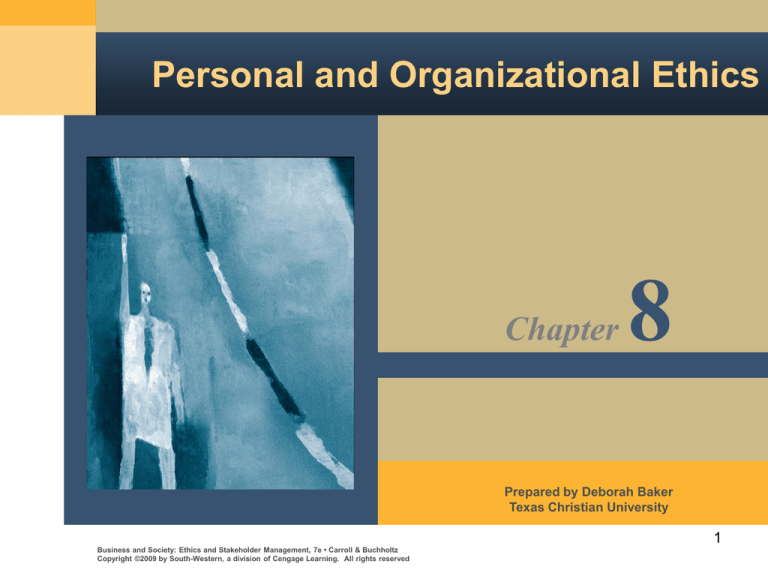
Personal and Organizational Ethics
Chapter
8
Prepared by Deborah Baker
Texas Christian University
Business and Society: Ethics and Stakeholder Management, 7e • Carroll & Buchholtz
Copyright ©2009 by South-Western, a division of Cengage Learning. All rights reserved
1
Chapter 8 Learning Outcomes
1. Understand the different levels at which business ethics
2.
3.
4.
5.
may be addressed.
Differentiate between consequence-based and
duty-based principles of ethics.
Enumerate and discuss principles of personal ethical
decision making and ethical tests for screening ethical
decisions.
Identify the factors affecting an organization’s moral
climate and provide examples.
Describe and explain actions, strategies, or “best
practices” to improve an organization’s ethical climate.
2
Chapter 8 Outline
Levels at Which Ethics May Be Addressed
Personal and Managerial Ethics
Managing Organizational Ethics
From Moral Decisions to Moral Organizations
Summary
Key Terms
Discussion Questions
3
Introduction to Chapter 8
This chapter focuses on the day-to-day ethical
issues that managers face
Many managers have no training in business ethics
or ethical decision making
Ethics is vital to business success
4
Levels at Which Ethical Issues
May Be Addressed
Personal
Level
Organizational
Level
Situations faced in our personal
lives outside the work context
Workplace situations faced as
managers and employees
5
Levels at Which Ethical Issues
May Be Addressed
Industry
Level
Societal and
Global Levels
Situations where a manager or
organization might influence
business ethics at the industry level
Local-to-global situations
confronted indirectly as a
management team
6
Personal and Managerial Ethics
Conventional approach
Resolving
Ethical
Conflicts
Principles approach
Ethical tests approach
7
Types of Ethical Principles
Teleological
Theories
Focus on the consequences or
results of the actions they produce
Deontological
Theories
Focus on duties
Aretaic
Theories
Focus on virtue
8
Principles Approach to Ethics
Major Principles of Ethics
Utilitarianism
Rights
Justice
Care
Virtue ethics
Servant leadership
Golden Rule
9
Principle of Utilitarianism
Utilitarianism focuses on acts that produce the
greatest ratio of good to evil for everyone
Strengths
Forces thinking about the
general welfare and
stakeholders
Allows personal decisions to fit
into the situation complexities
Weaknesses
Ignores actions that may be
inherently wrong
May come into conflict with
the idea of justice
Difficult to formulate satisfactory
rules for decision making
10
Kant’s Categorical Imperative
Kant’s Categorical Imperative is a duty-based principle of
ethics. A sense of duty arises from reason
or rational nature.
Formulations
1.
Act only on rules that you would be willing to see
everyone follow.
2.
Act to treat humanity in every case as an end and
never as a means.
3.
Every rational being is able to regard oneself as a maker
of universal law. We do not need an external authority
to determine the nature of the moral law.
11
Principle of Rights
Principle of Rights focuses on examining and possibly
protecting individual moral or legal rights
12
Principle of Rights
Figure 8-1
13
Principle of Justice
Principle of justice involves considering what alternative
promotes fair treatment of people
Types of justice
Distributive
Compensatory
Procedural
Rawlsian
14
Ethical Due Process
Process Fairness
1. Have employees been given input into the decision
process?
2. Do employees believe the decisions were made and
implemented in an appropriate manner?
3. Do managers provide explanations when asked? Do
they treat others respectfully? Do they listen to
comments being made?
15
Rawls’s Principles of Justice
1. Each person has an equal right to the most basic
liberties compatible with similar liberties for others
2. Social and economic inequalities are arranged so that
they are both:
a) reasonably expected to be to everyone’s advantage
and
b) attached to positions and offices open to all
16
Ethic of Care and Virtue Ethics
Principle of caring focuses on a person as a relational
(cooperative) and not as an individual
Feminist theory
Virtue ethics focuses on individuals becoming
imbued with virtues
Aristotle and Plato
17
Servant Leadership
Servant leadership focuses on serving others
first, such as employees, customers, and community
18
Servant Leadership
Characteristics of Servant Leaders
Listening
Empathy
Healing
Persuasion
Awareness
Foresight
Conceptualization
Commitment to the growth
of people
Stewardship
Building community
Bridges
Business Ethics
and
Leadership
19
The Golden Rule
The Golden Rule focuses on the premise
that you should do unto others as
you would have them do unto you
The Golden Rule is…
1. accepted by most people
2. easy to understand
3. a win-win philosophy
4. a compass when you need direction
20
Ethical Principles
The Categorical Imperative
The Conventionalist Ethic
The Disclosure Rule
The Golden Rule
The Hedonistic Ethic
The Intuition Ethic
The Market Ethic
Figure 8-2
The Means-Ends Ethic
The Might-Equals-Right Ethic
The Organization Ethic
The Professional Ethic
The Proportionality Principle
The Revelation Ethic
The Utilitarian Ethic
21
Reconciling Ethical Conflicts
Concerns to be Addressed in Ethical Conflicts
Obligations
Ideals
Effects
22
Guidelines for Conflicting
Obligations, Ideals, and Effects
When two or more moral obligations conflict,
choose the stronger one
When two or more ideals conflict, or when ideals
conflict with obligations, honor the more important one
When effects are mixed, choose the action that
produces the greater good or less harm
23
Ethical Tests Approach
Test of Common Sense
Test of One’s Best Self
Test of Making Something Public
Test of Ventilation
Test of the Purified Idea
Big Four (greed, speed, laziness, or haziness)
Gag Test
24
Factors Affecting the
Morality of Managers
Society’s Moral Climate
Business’s Moral Climate
Industry’s Moral Climate
Organization’s Moral Climate
Superiors
Individual
One’s Personal
Situation
Policies
Peers
25
Figure 8-4
Factors Affecting the
Organization’s Moral Climate
1. Behavior of superiors
2. Behavior of one’s peers in the organization
3. Ethical practices of one’s industry or profession
4. Society’s moral climate
5. Formal organizational policy (or lack of one)
6. Personal financial need
Figure 8-5
26
Pressures Exerted on Employees
by Superiors
Managers feel under pressure to compromise
personal standards to achieve company goals.
Top management:
50 percent agreed
Middle management:
65 percent agreed
Lower management:
85 percent agreed
27
Questionable Organizational Climates
Questionable Behaviors of Superiors or Peers
Unethical acts, behaviors or practices
Acceptance or legality as a standard of behavior
Bottom-line mentality, expectations of loyalty and
conformity
Absence of ethical leadership
Objectives and evaluation systems that overemphasize
profits
Insensitivity toward how subordinates perceive pressure
to meet goals
Inadequate formal ethics policies
Amoral decision making
28
Figure 8-6
Improving the Ethical Climate
Ethics Programs
and Officers
Realistic
Objectives
Ethical DecisionMaking Processes
Board of Directors’
Oversight
Ethics Audits and
Risk Assessments
Effective
Communication
Top
Management
Leadership
Moral
Management
Ethics Training
Corporate
Transparency
Codes of
Conduct
Figure 8-7
Discipline of
Violators
Whistle-Blowing
Mechanisms
29
Pillars of Leadership
Traits
Role
Modeling
Behaviors
Ethics
Communication
Decision
Making
Effective Rewards
and Discipline
Moral Manager
Moral Person
Ethical Leadership
30
Ethical Leadership Characteristics
Articulate and embody the purpose and values of the
organization
Focus on organizational success rather than on personal ego
Find the best people and develop them
Create a living conversation about ethics, values, and value for
stakeholders
Create mechanisms of dissent
Take a charitable understanding of others’ values
Make tough calls while being imaginative
Know the limits of the values and ethical principles they live
Frame actions in ethical terms
Connect the basic value proposition to stakeholder support
and societal legitimacy
31
Effective Communication
Candor
Fidelity
Confidentiality
32
Features of Ethics Programs
Written standards of conduct
Ethics training
Mechanisms to seek ethics advice or information
Methods for reporting misconduct anonymously
Disciplinary measures for employees who violate
ethical standards
Inclusion of ethical conduct in the evaluation of
employee performance
33
Key Elements for Ethics Programs
Compliance standards
High-level ethics personnel
Avoidance of delegation of undue discretionary authority
Effective communication
Systems for monitoring, auditing, and reporting
Enforcement
Detecting offenses, preventing future offenses
Keeping up with industry standards
Figure 8-8
Source: U.S. Sentencing Commission Guidelines
34
Ethical Decision-Making Process
Figure 8-9
35
Ethics Check
1. Is it legal?
2. Is it balanced?
3. How will it make me feel about myself?
36
Texas Instruments Ethics Quick Test
1. Is the action legal?
2. Does it comply with our values?
3. If you do it, will you feel bad?
4. How will it look in the newspaper?
5. If you know it’s wrong, don’t do it.
6. If you’re not sure, ask.
7. Keep asking until you get an answer.
37
Sears’ Guidelines
1. Is it legal?
2. Is it within Sears’ shared beliefs and policies?
3. Is it right / fair / appropriate?
4. Would I want everyone to know about this?
5. How will I feel about myself?
38
Benefits of Ethics Codes
1. Legal protection for the company
2. Increased company pride and loyalty
3. Increased consumer / public goodwill
4. Improved loss prevention
5. Reduced bribery and kickbacks
6. Improved product quality
7. Increased productivity
39
Content of Codes of Conduct
Employment practices
Employee, client, and vendor information
Public information / communications
Conflicts of interest
Relationships with vendors
Environmental issues
Ethical management practices
Political involvement
40
How Codes of Conduct Influence Behavior
Codes of Conduct act as a…
1.
2.
3.
4.
Rule book
Signpost
Mirror
Magnifying glass
5.
6.
7.
8.
Shield
Smoke detector
Fire alarm
Club
41
Purposes of Ethics Training
1.
2.
3.
4.
5.
6.
7.
Increase the manager’s sensitivity to ethical problems
Encourage critical evaluation of value priorities
Increase awareness of organizational realities
Increase awareness of societal realities
Improve understanding of the importance of public image
Examine the ethical facets of business decision making
Bring about a greater degree of fairness and honesty in the
workplace
8. Respond more completely to the organization’s social
responsibilities
42
Corporate Transparency
Corporate
Transparency
A quality, characteristic, or state
in which activities, processes,
practices, and decisions that take
place in companies become open or
visible to the outside world.
43
Board of Director
Leadership and Oversight
The 2002 Sarbanes-Oxley Act
Companies are required to protect whistle-blowers
without fear of retaliation
It is a crime to alter, destroy, conceal, cover up, or
falsify documents to prevent its use in a federal
government lawsuit
44
From Moral Decisions to
Moral Organizations
Moral Decisions
Moral Managers
Moral Organizations
Figure 8-10
45
Key Terms
Aretaic theories
Categorical imperative
Codes of conduct
Codes of ethics
Compensatory justice
Corporate transparency
Deontological theories
Distributive justice
Ethic of care
Ethical due process
Ethical tests
Ethics audits
Ethics officer
Ethics programs
Golden Rule
Legal rights
Moral rights
Negative right
Opacity
Positive right
Principle of justice
Principle of rights
Principle of utilitarianism
Procedural justice
Rights
Risk assessments
Servant leadership
Teleological theories
Transparency
Utilitarianism
Virtue ethics
46







